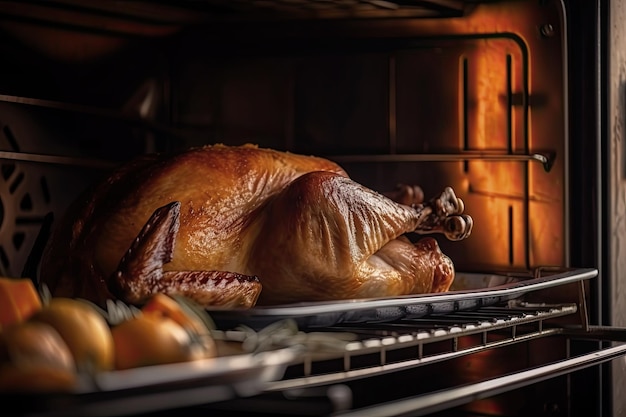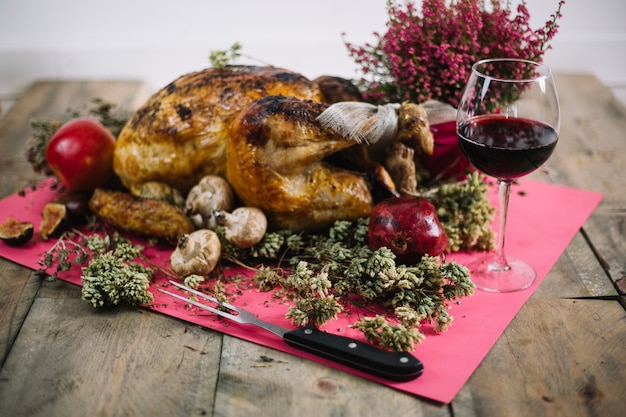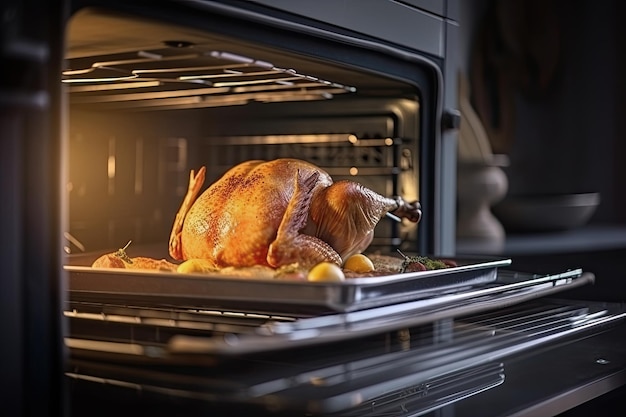Ah, the turkey. A majestic centerpiece that brings families together around the table, filling the air with irresistible aromas. But achieving the perfect roast turkey, succulent and juicy, requires a bit of know-how. Let's face it, nobody wants a dry, overcooked bird! We're aiming for a symphony of flavors, a tender masterpiece that melts in your mouth.
As a seasoned home cook, I've navigated the world of turkey roasting, experiencing my fair share of triumphs and the occasional culinary disaster. But, over time, I've learned the secrets to consistently achieving that juicy, flavorful bird. So, grab a cuppa, cozy up, and let's delve into the captivating world of turkey oven temperature and all its intricacies.
(Part 1) Setting the Stage: Understanding the Fundamentals

Before diving into the specifics of oven temperature, let's lay the foundation. Grasping a few key factors will set the stage for your turkey roasting success.
Turkey Size Matters: From Petite to Mighty
The first thing to consider is the size of your turkey. A petite bird will cook faster than its larger counterpart, demanding adjustments to cooking time. Always weigh your turkey beforehand! A good rule of thumb is to allow roughly 15 minutes per pound of turkey for roasting, but remember, this is just a starting point.
The Importance of Stuffing: A Delicious, Yet Delicate Element
Stuffing adds a delightful layer of flavor and texture to a roast turkey. However, it can also add a bit of complexity. If you're stuffing your turkey, you'll need to factor in extra cooking time to ensure the stuffing reaches a safe internal temperature of 165°F (74°C).
Why is this so important? Because stuffing cooks at a lower temperature than the turkey itself, and it's vital to avoid any potential foodborne illnesses. Consider cooking your stuffing separately in a baking dish for a safer and more controlled approach. It also allows you to monitor the doneness with a thermometer, ensuring that everyone enjoys a delicious and safe meal.
Don't Rush It: The Importance of Resting
Once your turkey has emerged from the oven, don't be tempted to immediately carve it. Give it a good 15-20 minutes to rest. This allows the juices to redistribute throughout the bird, resulting in a more succulent and flavorful meal. Trust me, that extra patience pays off!
(Part 2) The Oven Temperature: The Heart of the Matter

Now, let's address the heart of the matter: oven temperature. It's a balancing act that requires a little finesse, but with the right approach, you can achieve that perfect roast. While there's no single magic number, the general consensus points to a range that delivers stellar results.
The Golden Standard: 325°F (163°C)
This classic oven temperature for roasting turkeys has earned its reputation for good reason. It allows the turkey to cook evenly without drying it out. At 325°F, you can expect a roasting time of 3-4 hours, depending on the size of your turkey. This is a safe bet, a reliable starting point for most home cooks.
The High Heat Option: 375°F (190°C)
If you're pressed for time or prefer a crispier skin, a higher oven temperature might seem tempting. However, be cautious! This approach requires a watchful eye and adjustments to cooking time. 375°F can be a bit trickier, leading to overcooked turkey if you're not careful. I recommend it only if you're confident in your skills and have experience with high-heat roasting.
(Part 3) Mastering the Art of Roasting: From Prep to Perfection

With the oven temperature settled, let's delve into the artistry of the roasting process itself. It's a dance that combines precision with a touch of intuition.
Prepare for Success: The Power of Brining, Rubs, and More
Before even thinking about the oven, consider brining your turkey. Brining involves submerging the turkey in a salt-water solution, a technique that works wonders for keeping the meat moist and flavorful. You can add herbs and spices to your brine for an extra dimension of taste.
To achieve that crispy, golden skin, rub your turkey with a blend of herbs, spices, and butter. This creates a flavorful crust and prevents the skin from drying out. Don't forget to pat the turkey dry before roasting.
The Art of Roasting: A Culinary Symphony
Place your prepared turkey in a roasting pan and slide it into your preheated oven. Don't forget your trusty meat thermometer! The turkey is cooked through when the internal temperature reaches 165°F (74°C) in the thickest part of the thigh.
Basting: A Touch of TLC
Basting, a simple yet effective technique, involves pouring the juices from the pan over the turkey during roasting. This helps to keep the bird moist and adds an extra layer of flavor. You can baste with melted butter, wine, or a combination of both. Every basting is a little act of love that enhances the turkey's taste and texture.
(Part 4) Navigating Temperature Fluctuations: Oven Personalities
Not all ovens are created equal. Some run hotter or cooler than others, making it essential to understand your oven's quirks and calibrate it for success.
Calibrating Your Oven: A Vital Step
Invest in an oven thermometer to verify the actual temperature inside your oven. This tool will help you adjust the oven temperature if it's running too hot or too cold. For instance, if your oven is consistently 25°F (14°C) hotter than the setting, you'll need to reduce the temperature accordingly.
The Oven Door: A Key Player
Constantly opening the oven door during roasting can significantly disrupt the internal temperature. This can lead to uneven cooking and a dry bird. Try to limit your peeking as much as possible to maintain a stable environment inside.
Convection Ovens: A Game-Changer
Convection ovens are known for their faster and more even cooking, thanks to their built-in fans that circulate hot air. If you're using a convection oven, you might need to adjust the oven temperature down by 25°F (14°C) to prevent overcooking. However, always refer to your oven's manual for specific instructions.
(Part 5) Time to Tackle the Turkey: Oven Temperature vs. Cooking Time
The cooking time for your turkey depends on its weight and the chosen oven temperature. Here's a handy table to help you estimate the appropriate roasting time:
| turkey weight (lb) | Oven Temperature (°F) | Cooking Time (hours) |
|---|---|---|
| 8-12 | 325 | 3-3.5 |
| 12-16 | 325 | 3.5-4 |
| 16-20 | 325 | 4-4.5 |
| 20-24 | 325 | 4.5-5 |
Remember, these are just estimates. Always check the internal temperature of the turkey using a meat thermometer to ensure it's cooked through.
(Part 6) turkey thermometers: Your Trusty Companions
Speaking of internal temperature, a meat thermometer is an indispensable tool for any serious turkey roaster. It's the only way to guarantee that your bird is cooked to perfection.
Types of Thermometers: A World of Options
There are a variety of meat thermometers available, each with its own benefits:
- Instant-read thermometers: These thermometers offer quick and easy readings. Simply insert the probe into the thickest part of the thigh and get an immediate temperature reading.
- Leave-in thermometers: These thermometers feature a probe that remains inserted into the turkey throughout the roasting process. They continuously monitor the temperature, alerting you when the desired temperature is reached. This eliminates the need for constant checking and provides peace of mind.
Using a Thermometer Correctly: Ensuring Accuracy
When using a thermometer, insert the probe into the thickest part of the thigh, avoiding any bone. This ensures an accurate reading of the internal temperature. The turkey is cooked through when the internal temperature reaches 165°F (74°C). Don't settle for guessing – let a thermometer be your guide.
(Part 7) Don't Panic: Troubleshooting Turkey Troubles
Even the most seasoned cooks can encounter a few bumps in the road when roasting a turkey. But fear not, there are solutions to common turkey troubles.
The Turkey is Overcooked: A Dry Bird Dilemma
If your turkey is overcooked, it's likely to be dry and tough. To prevent this, ensure you're using the correct cooking time and check the internal temperature regularly. If you suspect your turkey is overcooked, take it out of the oven immediately and let it rest. This allows the juices to redistribute, potentially making the meat more tender.
The Turkey is Undercooked: A food safety Concern
If your turkey is undercooked, it poses a food safety hazard. It's crucial to ensure that the internal temperature reaches 165°F (74°C) to eliminate any harmful bacteria. If you're unsure, cook the turkey for a bit longer or return it to the oven for a bit more time.
The Skin is Not Crispy: A Culinary Conundrum
If the skin is not as crispy as you'd like, try increasing the oven temperature for the last 30 minutes of cooking. You can also tent the turkey with foil for the initial part of the cooking time, then remove it for the final 30 minutes to let the skin crisp up. This allows the skin to brown and develop a lovely crispness while preventing the meat from overcooking.
(Part 8) The After-Roast Routine: Resting, Carving, and Serving
Your turkey is out of the oven, and it looks magnificent. But hold your horses! It's crucial to let it rest for 15-20 minutes before carving. This allows the juices to redistribute, resulting in a juicier and more flavorful turkey. Patience is a virtue in turkey roasting!
Carving with Confidence: A Culinary Art
When it's time to carve, use a sharp carving knife and follow the natural lines of the breast bone. You can remove the drumsticks and wings first, then carve the breasts into thin slices. If you're feeling unsure, there are plenty of helpful online guides to guide you through the process. Carving can be a little daunting, but with practice, it becomes a satisfying skill.
Serving with Style: A Celebration of Flavor
Now, it's time to enjoy the fruits of your labor! Arrange your turkey slices on a platter, alongside your favorite sides, and celebrate your culinary triumph. Share the meal with loved ones, creating cherished memories around the table.
FAQs: Addressing Your Burning Turkey Questions
Here are some frequently asked questions about turkey oven temperature and roasting:
1. How do I know if my turkey is cooked through?
The most reliable way to determine if your turkey is cooked through is to use a meat thermometer. Insert the probe into the thickest part of the thigh, avoiding any bone. The turkey is cooked through when the internal temperature reaches 165°F (74°C).
2. What should I do if my oven is running too hot or too cold?
Use an oven thermometer to calibrate your oven. If it's running too hot, reduce the temperature by the difference. If it's running too cold, increase the temperature accordingly. Adjustments are key to achieving consistent results.
3. What is the best way to ensure a crispy turkey skin?
Pat the turkey dry before roasting and rub it with a mixture of herbs, spices, and butter. You can also increase the oven temperature for the last 30 minutes of cooking to help the skin crisp up. A crispy skin adds a delightful texture and visual appeal to your roast.
4. How do I prevent my turkey from drying out?
Brining your turkey before roasting is a fantastic way to keep it moist. Also, ensure you don't overcook it. Use a meat thermometer to check the internal temperature and take the turkey out of the oven when it reaches 165°F (74°C). Overcooking is the enemy of a juicy turkey.
5. What is the best way to store leftover turkey?
Refrigerate leftover turkey in an airtight container within two hours of cooking. It should be consumed within three to four days. Proper storage ensures that your leftover turkey remains safe and delicious.
I hope this comprehensive guide has equipped you with the knowledge and confidence to roast a delicious, juicy turkey. Remember, practice makes perfect! Keep experimenting, try different techniques, and most importantly, have fun with it. Happy cooking!
Everyone is watching

How to Cook Frozen Lobster Tails Perfectly: A Step-by-Step Guide
RecipesLobster. Just the word conjures up images of lavish meals, special occasions, and a taste of luxury. But let's...

Pigs in a Blanket Cooking Time: How Long to Bake for Perfect Results
RecipesAh, pigs in a blanket. Just the name conjures up images of those delightful little parcels of crispy pastry en...

Pork Fillet Cooking Time: How Long to Cook It Perfectly
RecipesPork fillet, or tenderloin as it's sometimes called, is a real favourite in our house. It's so versatile, and...

The Ultimate Guide to Tender, Juicy Pulled Pork
RecipesRight, let's talk pulled pork. It's one of those dishes that just screams "comfort food," doesn't it? I mean...

The Ultimate Guide to Cooking Sweet Potatoes: From Roasting to Mashing
RecipesSweet potatoes. Just the name conjures up images of warm, comforting dishes, bursts of vibrant color, and a to...
